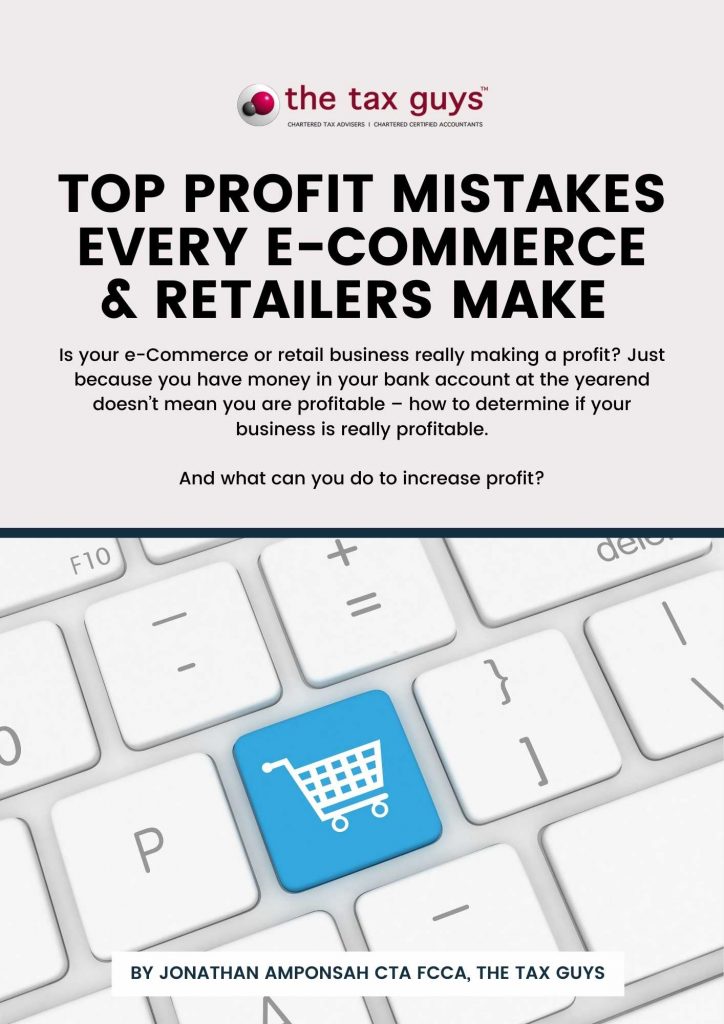
Making a profit is the financial point of a business – without it, there is no business and whatever else you are hoping to achieve through your business (helping people, changing the world, supporting your family) will not be possible unless you are profitable. Yet, in my experience, far too many entrepreneurs don’t really understand profit – what it is or how to ensure they make it.
HERE ARE THE 12 BIGGEST, AND MOST COMMON, PROFIT MISTAKES THAT ENTREPRENEURS MAKE:
- Bank Balance Accounting
As a business owner, you’ve heard the phrase “Cash Is King” so many times that it starts to feel like more cash means more profit. You then start to gauge the profitability of your business based on the bank balance. This is a common mistake I see so often. Here are 7 reasons why you might actually be making a loss in your business despite the cash in your bank account:
. You have not paid your suppliers or other creditors
. Payroll expenses have not been reflected in the accounts
. You are not paying yourself a reasonable salary
You haven’t made adjustments for all expenses
. You have not taken any reasonable drawings or dividends
. The cash is from last year’s profits
The above list is not exhaustive but covers the common areas where your cash will go. So the next time your accountant presents you with accounts with less-than-expected profit figures, have a conversation and go through the above list together with other factors specific to your business.
2. Margins, Margins, and Margins
This is an important indicator of profitability, but it’s vastly ignored or misunderstood among most e-commerce retailers. The next time you get your accounts, take the direct costs of sales or direct expenses out from the revenue. Then divide that number by the revenue. That is your gross profit margin. Let’s say your revenue is £1,000 and your materials or direct labor or direct expenses cost you £700.
The difference of £300 divided by £1,000 revenue gives you a margin of 30%. This means that for every £1 of sale, you are making 30p in gross profit. This tells you how profitable you are at the gross margin level. You can also compare this 30% to the industry average to gauge where you are at. If this margin is so low, then you’re unlikely to be making a net profit because there won’t be enough to cover your overheads.
3. Wrong Calculation of Price
Having ascertained your profit margins of 30%, a common and huge mistake I see is as follows. You get your stock in for say 1 product line. You perhaps add delivery, packaging, and amazon selling costs Let’s say £10. What do you do next? You apply 30% to the overall costs. You then quote £13 for the product. Sounds familiar? And it makes sense right? Well not quite. If you take your £10 costs from the £13 price you get £3. Now divide that by £13. You now get 23%. You’ve just lost a 7% profit margin without even blinking.
And this mistake will make its way down to the net profit figure causing you to be less profitable year after year.
4. Fear of Price Increase
Having realized that you’ve been under-quoting for jobs or that your costs have gone up, another classic mistake is to put off price increases for fear of losing customers. Yes, you will lose some customers but let’s do some maths. Let’s say you have 2000 customers and your price is £13 per customer. (£26,000 revenue) If you put prices up by 10%, your new revenue will be £28,600.
5. Cutting The Wrong Expenses
You realize the cash at the bank is not yours and that you are not making profits. So panic sets in and you’re determined to cut costs to make profits. Here’s the thing though: Not all expenses will have a greater impact on your profits. A study by McKinsey and Co (a global consulting firm) revealed that whilst a 1% reduction in fixed costs can have around a 2% increase in profits, the same reduction in variable costs has a bigger 7% increase in profits. So instead of going for cost-cutting at all costs (no pun intended here) conduct a cost-benefit analysis and focus on variable or direct costs first.
6. Ignoring the power of 1
Incidentally, the same studies also revealed that increasing pricing has a bigger influence on your profits than reducing costs or increasing sales volumes.
But here is what most entrepreneurs do not consider doing: Assessing the power of a mere 1% increase in price, 1% increase in sales, 1% decrease in variable costs, and 1% decrease in fixed costs.
Next time you sit down with your accountant, ask him or her to run these numbers and show you the impact they will have on your profits. Would you lose a lot of customers due to a mere 1% increase in price?

7. Labour Costs
If you have staff, a common profit mistake is not measuring revenue per staff or profit per staff. This is simply taking the revenue or profits per year and dividing it by the number of staff. Let’s assume your income is £100,000 and you have four staff. Your revenue per staff is £25,000. Now compare that to the average cost per staff. This simple exercise will help focus your mind on what needs to be done to increase your profit.
8. Process Inefficiencies
Where labor profitability ratios such as the ones above are low, another mistake is to focus mainly on staff rather than both staff and process efficiencies. Dr. W Robert Deming, the father of quality evolution and systems once said “85% of the reasons for failure are deficiencies in systems and processes rather than employees”
The tip here is to review the seven wastes (Transportation, Inventory, Motion, Waiting, Overproduction, Over-processing, and Defects – Google ‘MUDA’ for more on this) that exist in all businesses and have the plan to reduce these in conjunction with staff training and engagement.
9. Flying Blind
Peter Drucker (the management guru) is often quoted as saying that “you can’t manage what you can’t measure”. When it comes to profits, the biggest mistake is not knowing the profit numbers that matter in your business. Your gross profit margin, profit per staff, profit per client or project, net profit margin, breakeven number, monthly costs, and prices are all important numbers to track and focus on. If you currently speak to your accountant once a year only to be told how much tax to pay with no access to your key numbers, then it is unlikely you will be able to improve on your results.
The good news is that with so many online accounting apps on the market, (FreeAgent, QuickBooks, and Xero), entrepreneurs should no longer be flying blind in their businesses.
10. Price Discounts
You’ve quoted a price for the job. The customer says “what can you do about the price” Do you get a knee-jerk reaction and offer price discounts to win the work? Let’s return to the above example (on margins) where you were making a 30% margin on sales of 1000. Let’s then assume you offer a 10% discount. Your revenue drops to £900 but you’ve kept your costs the same. Your margins drop to 22% (£900 less £700 divided by £900) The 10% discount now means a 26.6% drop in your margins (the original 30% less the current 22% dividend by the original 30%. This is just the beginning because it gets worse if we look at the impact this will have on the bottom line (net profit margin), assuming you keep all your overheads the same. Were you intending to have a 26.6% drop in your margins by offering a 10% discount?
The point here is to be aware of the profit effect of price discounts and use it to negotiate a better win-win deal for all.
11. Price Competition Without a Plan
The mistake I see here is to look at your competitors’ prices and undercut them in order to win business. Often this is done without a plan (short-term low-cost strategy or need to set up a no frills division to compete in the market). So, in long run, when you win more business you find yourself not making profits because your costs have gone up and it becomes challenging to raise your prices because you’ve attracted price-sensitive customers.
12. Not taking profits first
In his book Profit First, Mike Michalowicz makes a compelling case for opening another bank account and transferring your profits before you make payments to anyone. So, if you’ve worked out that your net profit on every sale is 10%, then a safe way to see and secure those profits is to transfer it straight away to your “profit bank account”. That way you are forced to make do with the remaining 90%.

CONCLUSION
Profit is like oxygen.
Your business cannot hold its breath for long without it, so it is essential you understand what profit is, how your business makes it, and what impacts your profit.
By understanding these key basics, you can focus on increasing your profit – and that means more money for you, and more money for your business
